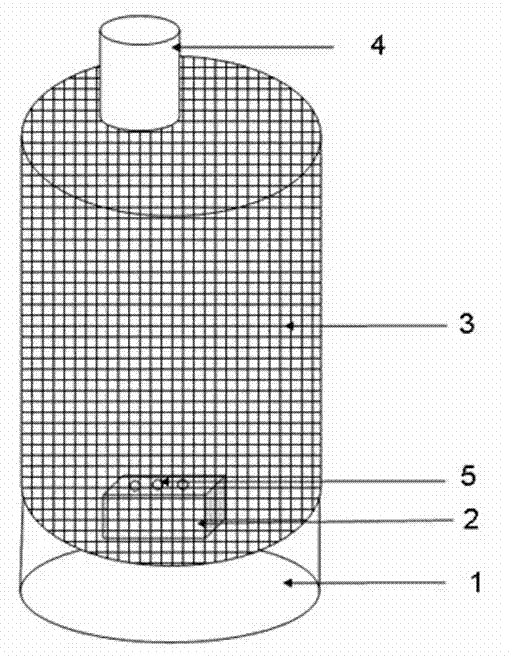Method for feeding lepidopteron
A technology for lepidopteran insects and adults, which is applied in the fields of chemistry, animal husbandry, etc., can solve the problems of egg hatching rate, larval pupation rate, pupa emergence rate and adult survival rate, low labor cost to capture adults, and adults waiting for an opportunity to escape, etc. Achieve the effect of improving egg hatching rate and pupae emergence rate, inhibiting bacterial proliferation and preventing insects from escaping
- Summary
- Abstract
- Description
- Claims
- Application Information
AI Technical Summary
Problems solved by technology
Method used
Image
Examples
Embodiment 1
[0034](1) Egg collection and disinfection: 2-3 days after adult eclosion in tray-type cages, plastic ropes were hung on the top of the cage, and eggs were collected from plastic ropes on the 5th day after adult eclosion, and then collected once a day for a total of Collect for 8-9 days; after the eggs are collected, sterilize the plastic rope with the eggs with a formaldehyde solution with a volume concentration of 3.7% for 15 minutes, then take them out with sterile tweezers and soak them in sterile water for 3 times, each time for 30 minutes; the soaking is over Then take it out and put it indoors to dry naturally;
[0035] (2) Egg hatching larvae and larva rearing: Spread 2-3 layers of absorbent paper on the bottom of the sterile feeding bottle, then put the plastic rope dried in step 1 in the sterile feeding bottle, seal it and place it in the light for cultivation Cultivate in an incubator under the conditions of temperature 22°C and photoperiod L:D=14h:10h; after 5 days ...
Embodiment 2
[0042] (1) Egg collection and disinfection: On the 2nd day after the adults in the tray-type cages eclosion, hang the plastic rope on the top of the cage, and collect the eggs from the plastic rope on the 3rd day after the adult eclosion, and then collect once a day for a total of 3 -5d; After the eggs are collected, sterilize the plastic rope with the eggs with a formaldehyde solution with a volume concentration of 3.7% for 10 minutes, then take them out with sterile tweezers and soak them in sterile water for 3 times, each time for 20 minutes; take them out after soaking Put it indoors to dry naturally;
[0043] (2) Egg hatching larvae and larva rearing: Spread 2-3 layers of absorbent paper on the bottom of the sterile feeding bottle, then put the plastic rope dried in step 1 in the sterile feeding bottle, seal it and place it in the light for cultivation Cultivate in an incubator under the conditions of temperature 28°C and photoperiod L:D=14h:10h; after 3 days of cultivati...
Embodiment 3
[0050] (1) Egg collection and disinfection: 2-3 days after the adults in the tray-type cages emerged, wrap gauze around the cages, collect eggs from the gauze on the 4th day after the adults emerged, and collect them once a day thereafter. 5-8d; After the eggs are collected, sterilize the gauze with the eggs with a formaldehyde solution with a volume concentration of 3.7% for 10 minutes, then take them out with sterile tweezers and soak them in sterile water for 3 times, each time for 20 minutes; take them out after soaking Put it indoors to dry naturally;
[0051] (2) Egg hatching larvae and larva rearing: Spread 2-3 layers of absorbent paper on the bottom of the sterile feeding bottle, then put the gauze dried in step 1 in the sterile feeding bottle, seal it and place it in the light incubator Medium culture, the culture conditions are temperature 25°C, photoperiod L:D=14h:10h, after 3-4 days of culture, the eggs hatch into larvae; after the larvae hatch, open the lid of the...
PUM
| Property | Measurement | Unit |
|---|---|---|
| thickness | aaaaa | aaaaa |
| diameter | aaaaa | aaaaa |
| length | aaaaa | aaaaa |
Abstract
Description
Claims
Application Information
 Login to View More
Login to View More - R&D
- Intellectual Property
- Life Sciences
- Materials
- Tech Scout
- Unparalleled Data Quality
- Higher Quality Content
- 60% Fewer Hallucinations
Browse by: Latest US Patents, China's latest patents, Technical Efficacy Thesaurus, Application Domain, Technology Topic, Popular Technical Reports.
© 2025 PatSnap. All rights reserved.Legal|Privacy policy|Modern Slavery Act Transparency Statement|Sitemap|About US| Contact US: help@patsnap.com

